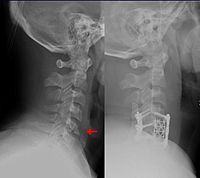
Photo from wikipedia
Study Design: Retrospective chart review. Objective: To determine the long-term efficacy of 2-stage total en bloc spondylectomy (TES). Summary of Background Data: TES is a well-described technique to achieve tumor-free… Click to show full abstract
Study Design: Retrospective chart review. Objective: To determine the long-term efficacy of 2-stage total en bloc spondylectomy (TES). Summary of Background Data: TES is a well-described technique to achieve tumor-free margins, but it is a highly destabilizing procedure that necessitates spinal reconstruction. A 2-stage anterior/posterior approach for tumor resection and instrumentation has been shown to be biomechanically superior to the single-stage approach in achieving rigid fixation, but few clinical studies with long-term outcomes exist. Methods: A retrospective review was performed on patients undergoing a 2-stage TES for a spinal tumor between 1999 and 2011. Results were compared with those from a literature review of case series, with a minimum of 2-year follow-up, reporting on a single-stage posterior-only approach for TES. Results: Seven patients were identified (average follow-up 52.7 mo). Tumor location ranged from T1 to L3 with the following pathologies: metastasis (n=3), hemangioma (n=1), leiomyosarcoma (n=1), giant cell tumor (n=1), and chordoma (n=1). There were no significant surgical complications. All 7 patients had intact spinal fixation. There were no failures of the orthogonal fixation (pedicle screws or anterior fixation). The average modified Rankin Scale scores improved from 2.7 preoperatively to 0.7 at last follow-up. None of the patients in our series suffered local disease recurrence at last follow-up or suffered neurological deterioration. These results were comparable with those noted in the literature review of posterior-only approach, where 12% of patients experienced instrument failure. Conclusions: TES is a highly destabilizing procedure requiring reconstruction resistant to large multiplanar translational and torsional loads. A 2-stage approach utilizing orthogonal vertebral body screws perpendicular to pedicle screws is a safe and effective surgical treatment strategy. Orthogonal spinal fixation may lower the incidence of instrumentation failure associated with complete spondylectomy and appears to be comparable with a single-stage procedure. However, larger prospective series are necessary to assess the efficacy of this approach versus traditional means.
Journal Title: Clinical Spine Surgery
Year Published: 2017
Link to full text (if available)
Share on Social Media: Sign Up to like & get
recommendations!